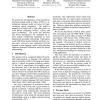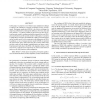66 search results - page 2 / 14 » Adapting acoustic and lexical models to dysarthric speech |
ICMI
2005
Springer
14 years 3 months ago
2005
Springer
Situated, spontaneous speech may be ambiguous along acoustic, lexical, grammatical and semantic dimensions. To understand such a seemingly difficult signal, we propose to model th...
ICASSP
2009
IEEE
14 years 4 months ago
2009
IEEE
We study key issues related to multilingual acoustic modeling for automatic speech recognition (ASR) through a series of large-scale ASR experiments. Our study explores shared str...
ACL
2004
13 years 11 months ago
2004
We present the first application of the head-driven statistical parsing model of Collins (1999) as a simultaneous language model and parser for largevocabulary speech recognition....
ICASSP
2009
IEEE
14 years 4 months ago
2009
IEEE
In this paper, we introduce a new histogram equalizationbased environmental model adaptation method for robust speech recognition in noise environments. The proposed method adapts...
ICASSP
2011
IEEE
13 years 1 months ago
2011
IEEE
In this paper, we propose a novel feature space adaptation technique to improve the robustness of speech recognition in noisy environments. Histogram equalization (HEQ) is an effe...


